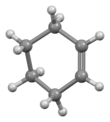| |||
| |||
| Names | |||
|---|---|---|---|
| Preferred IUPAC name Cyclohexene | |||
| Other names Tetrahydrobenzene, 1,2,3,4-Tetrahydrobenzene, Benzenetetrahydride, Cyclohex-1-ene, Hexanaphthylene, UN 2256 | |||
| Identifiers | |||
| CAS Number | |||
| 3D model (JSmol) | |||
| Beilstein Reference | 906737 | ||
| ChEBI | |||
| ChEMBL | |||
| ChemSpider | |||
| ECHA InfoCard | 100.003.462 | ||
| EC Number |
| ||
| Gmelin Reference | 1659 | ||
| PubChem CID | |||
| RTECS number |
| ||
| UNII | |||
| CompTox Dashboard (EPA) | |||
InChI
| |||
SMILES
| |||
| Properties | |||
| Chemical formula | C6H10 | ||
| Molar mass | 82.143 g/mol | ||
| Appearance | colorless liquid | ||
| Odor | sweet | ||
| Density | 0.8110 g/cm | ||
| Melting point | −103.5 °C (−154.3 °F; 169.7 K) | ||
| Boiling point | 82.98 °C (181.36 °F; 356.13 K) | ||
| Solubility in water | slightly soluble in water | ||
| Solubility | miscible with organic solvents | ||
| Vapor pressure | 8.93 kPa (20 °C)
11.9 kPa (25 °C) | ||
| Henry's law constant (kH) |
0.022 mol·kg·bar | ||
| Magnetic susceptibility (χ) | -57.5·10 cm/mol | ||
| Refractive index (nD) | 1.4465 | ||
| Hazards | |||
| GHS labelling: | |||
| Pictograms |     
| ||
| Signal word | Danger | ||
| Hazard statements | H225, H302, H305, H311, H411 | ||
| Precautionary statements | P210, P233, P240, P241, P242, P243, P264, P270, P273, P280, P301+P310, P301+P312, P302+P352, P303+P361+P353, P312, P322, P330, P331, P361, P363, P370+P378, P391, P403+P235, P405, P501 | ||
| NFPA 704 (fire diamond) |
 | ||
| Flash point | −12 °C (10 °F; 261 K) | ||
| Autoignition temperature |
244 °C (471 °F; 517 K) | ||
| Explosive limits | 0.8–5 % | ||
| Lethal dose or concentration (LD, LC): | |||
| LD50 (median dose) | 1407 mg/kg (oral, rat) | ||
| LCLo (lowest published) | 13,196 ppm (mouse, 2 hr) | ||
| NIOSH (US health exposure limits): | |||
| PEL (Permissible) | TWA 300 ppm (1015 mg/m) | ||
| REL (Recommended) | TWA 300 ppm (1015 mg/m) | ||
| IDLH (Immediate danger) | 2000 ppm | ||
| Safety data sheet (SDS) | External MSDS | ||
| Except where otherwise noted, data are given for materials in their standard state (at 25 °C , 100 kPa).
| |||
Cyclohexene is a hydrocarbon with the formula (CH2)4C2H2. It is an example of a cycloalkene. At room temperature, cyclohexene is a colorless liquid with a sharp odor. Among its uses, it is an intermediate in the commercial synthesis of nylon.
Production and uses
Cyclohexene is produced by the partial hydrogenation of benzene, a process developed by the Asahi Chemical company. The main product of the process is cyclohexane because cyclohexene is more easily hydrogenated than benzene.
In the laboratory, it can be prepared by dehydration of cyclohexanol.
- C6H11OH → C6H10 + H2O
Reactions and uses
Benzene is converted to cyclohexylbenzene by acid-catalyzed alkylation with cyclohexene. Cyclohexylbenzene is a precursor to both phenol and cyclohexanone.
Hydration of cyclohexene gives cyclohexanol, which can be dehydrogenated to give cyclohexanone, a precursor to caprolactam.
The oxidative cleavage of cyclohexene gives adipic acid. Hydrogen peroxide is used as the oxidant in the presence of a tungsten catalyst.
1,5-Hexadiene is produced by ethenolysis of cyclohexene. Bromination gives 1,2-dibromocyclohexane.
Structure
Cyclohexene is most stable in a half-chair conformation, unlike the preference for a chair form of cyclohexane. One basis for the cyclohexane conformational preference for a chair is that it allows each bond of the ring to adopt a staggered conformation. For cyclohexene, however, the alkene is planar, equivalent to an eclipsed conformation at that bond.
See also
References
- ^ NIOSH Pocket Guide to Chemical Hazards. "#0167". National Institute for Occupational Safety and Health (NIOSH).
- "Cyclohexene". Immediately Dangerous to Life or Health Concentrations (IDLH). National Institute for Occupational Safety and Health (NIOSH).
- Xie, Feng; Chen, Lihang; Cedeño Morales, Eder Moisés; Ullah, Saif; Fu, Yiwen; Thonhauser, Timo; Tan, Kui; Bao, Zongbi; Li, Jing (2024). "Complete separation of benzene-cyclohexene-cyclohexane mixtures via temperature-dependent molecular sieving by a flexible chain-like coordination polymer". Nature Communications. 15 (1): 2240. Bibcode:2024NatCo..15.2240X. doi:10.1038/s41467-024-46556-6. PMC 10933443. PMID 38472202.
- US 9771313, Narisawa, Naoki & Tanaka, Katsutoshi, "Cyclohexanol, method for producing cyclohexanol, and method for producing adipic acid", published 26 Sep 2017
- G. H. Coleman, H. F. Johnstone (1925). "Cyclohexene". Organic Syntheses. 5: 33. doi:10.15227/orgsyn.005.0033.
- B. B. Corson, V. N. Ipatieff (1939). "Cyclohexylbenzene". Organic Syntheses. 19: 36. doi:10.15227/orgsyn.019.0036.
- Plotkin, Jeffrey S. (2016-03-21). "What's New in Phenol Production?". American Chemical Society. Archived from the original on 2019-10-27. Retrieved 2018-01-02.
- Musser, Michael T. (2005). "Cyclohexanol and Cyclohexanone". Ullmann's Encyclopedia of Industrial Chemistry. Weinheim: Wiley-VCH. doi:10.1002/14356007.a08_217. ISBN 978-3527306732.
- Reed, Scott M.; Hutchison, James E. (2000). "Green Chemistry in the Organic Teaching Laboratory: An Environmentally Benign Synthesis of Adipic Acid". J. Chem. Educ. 77 (12): 1627–1629. Bibcode:2000JChEd..77.1627R. doi:10.1021/ed077p1627.
- H. R. Snyder, L. A. Brooks (1932). "1,2-Dibromocyclohexane". Organic Syntheses. 12: 26. doi:10.15227/orgsyn.012.0026.
- Jensen, Frederick R.; Bushweller, C. Hackett (1969). "Conformational preferences and interconversion barriers in cyclohexene and derivatives". J. Am. Chem. Soc. 91 (21): 5774–5782. doi:10.1021/ja01049a013.
External links
- International Chemical Safety Card 1054
- NIOSH Pocket Guide to Chemical Hazards. "#0167". National Institute for Occupational Safety and Health (NIOSH).
- Material Safety Data Sheet for cyclohexene
- Safety MSDS data
- Reaction of Cyclohexene with Bromine and Potassium Permanganate
- Cyclohexene synthesis
- Data sheet at inchem.org
| Cycloalkenes | |
|---|---|
| Alkenes | |
| Dienes |
|
| Trienes | |
| Tetraenes | |



